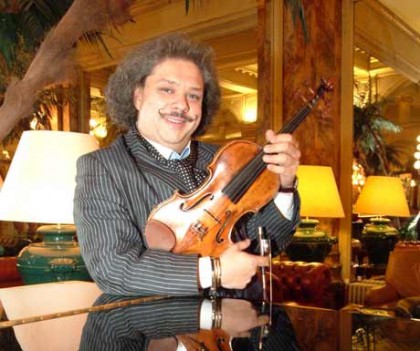Roby Lakatos brings gypsy fiddle panache to Cambridge

Roby Lakatos and his ensemble performed Friday night at the Sanders Theatre.
Before there was “world music”— a silly term Americans use for music by foreigners that’s not classical—there was gypsy music. Polymathic, unruly, improvisational and virtuosic, gypsy music strictly followed the gypsy rule, which is there are no rules.
Hungarian violinist Roby Lakatos, who brought his ensemble to Cambridge’s Sanders Theatre Friday evening as part of the Celebrity Series season, has roots that run deep in Roma musical history. He deems himself “a seventh generation Roma fiddler,” and counts the King of the Gypsy Fiddlers, János Bihari, a favorite of Liszt, in his family tree.
Lakatos’s ensemble—cimbalom, guitar, piano, bass and second violin—balanced the flamboyant frontman fiddler with jazz-style chops — now jamming seamlessly in the background, then stepping into the spotlight for flashy solos. The music—or more correctly the tunes that provided jumping off points for extended improvisations—was partly traditional, partly Lakatos’s own work, with some film-score snippets from Michel Legrand and Ennio Morricone thrown in. It’s a formula that works: although infrequently heard in the U.S., Lakatos tours the world and is particularly favored in Asia.
A suite of tunes from József Suha Balogh opened the evening, and set the standard for the rest of the performance: after an introduction, various solos would ensue, built around the jazz mode of “you’ve got eight (or sixteen) bars, do your thing.” Mainly it was Lakatos’ violin solos and his splendid technique was constantly on display. It was all there, lifted from the book of fiddler’s virtuosity: the spiccato, col legno, jeté and legato bowing, pizzicato that looked more like two arachnids wrestling on the strings, and fleet passages that defied the physics of Lakatos’ fingers.
Two pieces stood out in the first half: a foray into tango, Ástor Piazzolla’s Oblivion, with tasty interpolations by pianist Kalman Cséki and guitarist László Balogh; and a traditional tune, called Les Deux Guitares, with Lakatos doubling Balogh, his fiddle the second ax.
After the break, Lakatos let his extraordinary cimbalom player, Jenö István Lisztes, show off the range and tonal variety of that instrument. A derivative of hammered dulcimer, with more power and expressive capability, the cimbalom featured prominently all evening as the second melodic messenger. In a solo arrangement of Rimsky-Korsakov’s Flight of the Bumblebee, Lisztes raced through changes like a blur, belying his frantic mallet-work with an oddly dispassionate disposition.
A fanciful arrangement of Honeysuckle Rose followed, notable for Cséki’s inspired piano solo, which seemed, appropriately for a Hungarian comrade, to have some Liszt imbedded in it.
The audience was quick to recognize any hint of a traditional melody and jumped right in with rhythmic clapping. They were rewarded with two well-prepped encores, the celebrated Russian tune Black Eyes, and The Lark, a verbunkos style improvisational piece that had Lakatos spinning birdsong varieties with harmonics high and light on his fiddle.
Posted in Performances